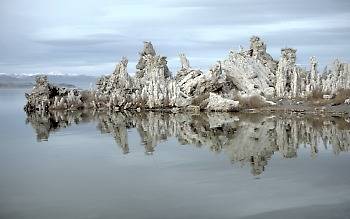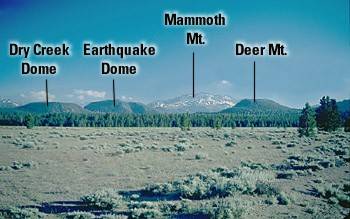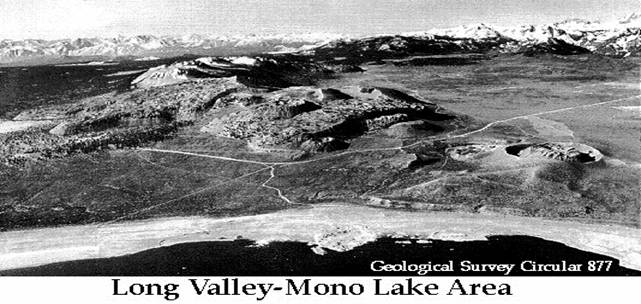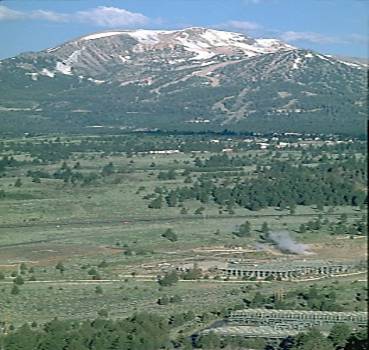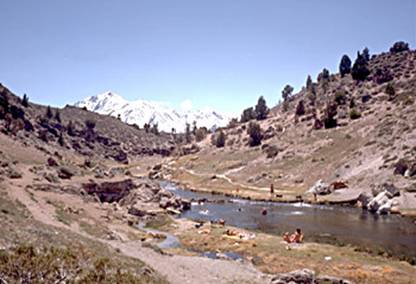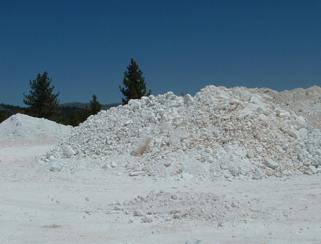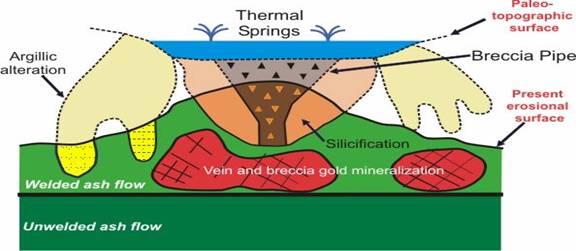Geology and Natural Heritage of the Long Valley Caldera
Hydrothermal System of the
Long Valley Caldera
Robert C. Pease
ABSTRACT
The Long Valley Caldera, a volcanically active region of the Eastern Sierra Nevada, was created 760,000 years ago by an explosive volcanic eruption. Since this eruption, volcanic activity and growing magma pits underground have created a hydrothermal system in the caldera in which water is heated by the magma as the magma rises. Different regions of the caldera have had different chemical alterations in their minerals due to the hydrothermal system being different in each part of the caldera. These chemical alterations have led to mining in the caldera. The hydrothermal system in the caldera has also led to other recreational, environmental, and industrial uses of the warm water.Introduction
A hydrothermal system, meaning “hot water”, is formed when groundwater is heated by rising magma. Results of this are hot springs , fumaroles, geysers, and mineral deposits. Differences between these four features are that fumaroles emit steam or other gases; geysers eject water once a portion has been turned to steam after being held in an underground storage department; hot springs are created when hydrothermal water and groundwater mix (CVO); and a mineral deposit from high energy water moving to a lower energy causing it to drop off minerals. In the Long Valley Caldera, an extensive hydrothermal system has evolved from snow and glacial melt from the Sierra Nevada Mountains flowing through intrusions in which magma is rising (Martini, 2002).
Hydrothermal systems have had profound influences on societies past and present. For Native Americans, hot springs were considered a sacred place where it was believed the warm, mineral water had healing powers ( Lund ). European settlers, later discovered the hot springs , enjoyed them, and decided to develop spas for commercial use ( Lund ). In Mono Lake , springs releasing calcium react with carbonates in the lake forming calcium carbonate, or limestone, resulting in tufa towers (Hill, 2006). These towers can stand several meters tall and have created a unique tourist destination.
Tufa deposits along shore of Mono Lake (Figure reproduced from USGS Photo)
Other implications of hydrothermal systems to be discussed in this essay are hydrothermal alteration, geothermal energy, and hydrothermal waters use in a fish hatchery within the Long Valley Caldera.
Geography
Three million six hundred thousand years ago, volcanic lava flows covered an area of fifteen hundred square miles with trachhybasalt and trachyandesite prior to rhyodacite eruptions creating lava flows and volcanic domes (Volcano World). Later, t he Long Valley Caldera was created in an explosive volcanic eruption 760,000 years ago (Hill, 2006) that spewed out 600 cubic kilometers of rock causing it to later collapse into a large caldera; 15 kilometers wide by 30 kilometers long (Dreger, Tkalcic, Johnston, 2000).
Since this very large eruption, more recent ones have led to the formation of Mammoth Mountain that has erupted as recently as 200 years ago (Martini, 2002). Mammoth Mountain is currently releasing carbon dioxide gas around Horseshoe Lake killing trees on its sides (Hill, 2006), a sign of unrest and a possible future eruption. This volcano forms the southwest edge of the Long Valley Caldera (Martini, 2002). The Mono-Inyo chain forms the western edge of the caldera and are a series of rhyolitic domes and craters forming as recent as 600 years ago, through eruptions caused by a build up of pressure created by steam pushing against a vent (USGS: Hydro). Eruptions on the Inyo chain began between 300,000 and 200,000 years ago; 35,000 years ago on the Mono chain with Black Point's eruption 13,000 years ago being the most recent (Volcano World).
Four structures formed by volcanic activity within the last 200,000 years (Figure reproduced from USGS photo)
Black Point was formerly an underwater volcano near the end of the last ice age but has since been exposed as water levels have fallen (Seekers). While erupting underwater, lava was cooled quickly, hardened and split forming fissures between 20 and 50 feet deep while only a few feet wide (Seekers).
Recent volcanic activity in the Mono-Inyo chain formed the Mono-Inyo domes in the fourteenth and fifteenth centuries (Hill, 2006). Around this time, three craters were formed on Deer Mountain (Hill, 2006). In Mono Lake , two large islands formed with the emergence of Negit and Paoha. Paoha, the more recent is a rhyolite dome that emerged sometime in the 18 th to mid-19 th century (Hill, 2006). Negit, a cinder cone volcano, emerged around 1700 years ago (Seekers).
Mono Craters chain, Mono Lake in front, Panum Crater central right (Figure reproduced from Volcano World)
In the center of the caldera, a resurgent dome has been forming through magma being pushed upwards from the old magma chamber. Eruptions close to every 200,000 years since the eruption 760,000 years ago have since built up its sides (Volcano World). On the southern edge of the resurgent dome, hydrothermal fluids have led to the formation of Hot Creek, Fumarole Valley , and Casa Diablo. The Hilton Creek Fault forms the border of the resurgent dome and eastern caldera (Martini, 2002).\
Hydrothermal Activity
The hydrothermal system of the Long Valley Caldera has developed through melt from surrounding mountains flowing into the caldera which is volcanically active (Martini, 2002). Through intrusions, water is able to come in contact with rising magma heating the water to around 220 degrees Celsius (USGS: Hydro). The current hydrothermal system of the Long Valley is probably coming at the tail-end of a high discharge period of hydrothermal activity which peaked at 40,000 years ago. A second period of high discharge probably occurred around 300,000 years ago with periods of less hydrothermal activity between. This was determined by viewing lake sediments near hot springs (Bailey, et al 1976). The original source of magma for hydrothermal activity is thought to have come from the Resurgent dome but the current source is probably from the Mono-Inyo volcanic chain (McConnell, et al., 1997). A possible explanation for this could be that the Resurgent dome was the dominant source of volcanic activity early on but more recently the Mono-Inyo volcanic chain has been more active.
A major result of the hydrothermal system of the Long Valley Caldera has been water's, especially when warm, ability to react in chemical reactions. This is called hydrothermal alteration and is the process of water dissolving minerals out of rock and then leaving the minerals as precipitates when the water has cooled and reached a lower energy state. Often times this process is carried out through addition or elimination reactions but for igneous rocks, substitution reactions take place commonly in which metallic ores are deposited in place of other minerals commonly found in the rock (Emmons, et al. 1960). This process can cause alterations significant enough that the original material is difficult to recognize. The areas of highest alteration are generally along the zones of highest permeability where the water is better able to come in contact with the rocks to be altered. These areas consist of faults, fractures, and other places in which the water and minerals can easily come into contact (Martini, 2002).
The hydrothermal system of the Long Valley Caldera is not homogenous though. In the Eastern part of the caldera there is an alkaline alteration in which hot, alkali-chloride rich water with a neutral to high pH can be found (Martini, 2002). The Eastern part is lower in elevation than the Western as it is not occupied by mountains or domes. This allows more water to flow through the Eastern part and is why Hot Creek and Fumarole Valley are located on the eastern half of the caldera along with Owens River which flows into Owens Lake , formerly the 2 nd largest lake in California before diversions from Los Angeles dried the lake ( Owens Lake ). This type of alteration yields amorphous silica from silicon (Martini, 2002). At higher elevations in the Western caldera and much of the Resurgent dome acid sulfate alteration from sulfur-rich gases is most common. This produces clays and sulfates in areas with little surface water flow (Martini, 2002).
Western caldera
A view of Mammoth Mountain with Casa Diablo geothermal energy plant in foreground, looking west from resurgent dome (Figure reproduced from USGS Photo)
Mammoth Mountain , formed between 200,000 and 50,000 years ago (Duke), is still currently volcanically active and showing signs of future eruptions. This long period of volcanic activity under Mammoth Mountain has led it to undergo much hydrothermal alteration because its magma has been heating water for a long time period. The summit has undergone the most alteration but each side of Mammoth Mountain has been affected differently by alteration and at different time periods (Martini, 2002). For example, the northern side is currently being altered through acid sulfate alteration by a fumarole. However, the southwest edge is covered with kaolinite and alunite from a fumarole during the Pleistocene period where a quarry dates rhyolite underneath the kaolinite at 30,000 years old (CSU Pomona). The alteration on Mammoth Mountain is found predominately near faults, of which a north running fault runs through the quarry of kaolinite forming a graben (CSU Pomona).
Nearby Mammoth Mountain , “Earthquake Fault” is a north trending fissure. Possibly an earthquake in 1980 reactivated the fissure (CSU Pomona) causing a rope to be placed around the fissure to keep people from walking down into it. This is an example of an earthquake altering a hydrothermal system. Earthquakes or other volcanic activity in which the ground moves can alter the flow of water underground. This can activate “dead” fissures or turn off active fissures which could explain why different areas of Mammoth Mountain have been altered by fissures at different times (Martini, 2002).
An important consequence of this is present at Casa Diablo, a geothermal energy station located at the southern edge of the resurgent dome, as an earthquake could switch the location of warm water pits away from their production wells and two normal faults are located nearby to the west of the power plant (UC Santa Cruz). Along the faults near Casa Diablo, most of its alteration has taken place forming alunite and kaolinite at high temperatures (Martini, 2002). The shallow depth of the Long Valley hydrothermal system makes drilling here easier as most of the hydrothermal water in the caldera is located roughly 1 kilometer underground in a layer of Bishop Tuff (Martini, 2002). However, the water is higher at the edge of the dome, where Casa Diablo is located and wells only 500 feet deep can reach water that is 300-350 degrees Fahrenheit, much cooler than deeper water would be and more accessible. The shallowness of Casa Diablo makes it a threat to have cooler water from the edge of the caldera flow in. Around the caldera, deeper underground, is a cooler pit of water that has not been heated by magma which Bishop Tuff and its clays act as a barrier from to keep the cooler water separate from the warmer (Suemnicht, et al 2007) enabling the warmer water supply of Casa Diablo to remain intact.
The Mono-Inyo domes stretch 30 miles from the north of Mammoth Mountain to Mono Lake along a fissure system forming the western edge of the caldera (Volcano World) and have also been altered through similar processes to those found on Mammoth Mountain resulting in kaolinite and alunite on the dome, with a greater concentration of hematite (Martini, 2002). Most of the alteration of the domes is present on the southern side and in a north-northwest direction along that of the Discovery Fault Zone. However, in the craters, most of the alteration is found inside the crater and not along the fault (Martini, 2002). This could be because the Mono Craters are considered to be the youngest mountain range in North America (Duke) which has not yet allowed alteration to reach the faults.
Central caldera
The majority of alteration in the central caldera is present on the resurgent dome due to the presence of fumaroles such as those present at Casa Diablo and Fumarole Valley . These fumaroles by emitting steam and gas have created kaolinite and alunite (Martini, 2002). Other altered areas on the dome were probably formed in a similar manner but by fumaroles that are not currently active.
The largest springs to release hydrothermal water in the caldera are present at Hot Creek Gorge where roughly 80% of the total water discharge is released (USGS: Hydro). Springs here release roughly 250 liters per second of heated water (USGS: Hydro) in an important part of the hydrothermal cycle of the caldera. Water brought into the hydrothermal cycle enters through snow melt from the Sierra Nevada Mountains at the western and southern edges of the caldera, then is heated deep underground by magma chambers under the Mono-Inyo volcanic chain. The warm water then rises through fractures to 1-2 kilometers because it is less dense than cooler water. The water then flows downhill from the west to the resurgent dome in the southeast and finally east of the resurgent dome to Hot Creek for the water to leave the system (USGS, Hydro).
At the point of hydrothermal discharge, the sides of the gorge are altered predominately to kaolinite with travertine deposits lining the bottom (Martini). The pattern of alteration here also follows that of several north-trending faults, as does the flow of the hydrothermal water (Vasco).
Image of Hot Creek Gorge (Figure Reproduced from USGS Photo)
Benefits to humans of the hot springs are that warmer waters can trigger some fish to grow faster. At Hot Creek Fish Hatchery, water temperatures are close to 40 degrees Fahrenheit warmer than at nearby streams from a spring warming the water, although containing only 2-5% hydrothermal fluids (USGS: Hydro). This has created one of the largest hatcheries in the country which stocks trout in Eastern Sierra streams (Hot Creek Hatchery Foundation).
Eastern Caldera
To the east of Hot Creek in the eastern caldera, there is much less alteration but that which does exist is predominately amorphous silica and kaolinite (Martini, 2002). Here there are spots of localized heat sources much smaller than in the other regions of the caldera and a fracture zone in the northeast corner. Along the fracture zone, amorphous silica is predominate while the heat sources provide kaolinite to the west of the fracture zone (Martini, 2002).
Mining
Alteration of lakebed sediments from the ice age and rhyolite that have formed kaolinite on the resurgent dome are currently being mined at the Huntley kaolinite pit within the Inyo National Forest . The kaolinite after being mined is then shipped off to be crushed and used in cosmetics, cements, and other products as a whitening agent (CSU Pomona).
Huntley Kaolinite Pit (Figure reproduced from CSU Pomona)
Nearby, along the north-south trending Hilton Creek Fault, low grades of gold and silver have been mineralized (SEC) in a blue chert mine. The remnants of an old hot spring, the mine formed from silica being deposited by the hot water as the water cooled and lost energy to carry the silica on its way out of the hot spring eventually leading to the hot spring sealing itself shut. Once enclosed the hot spring remained dormant until reopened by seismic activity, once this happened, the trapped hydrothermal fluids violently ejected shattering the rock and creating a breccia pipe (CSU Pomona).
Gold was then filtered out through the “acid-sulfate gold model” in which bisulfide dissolves gold, similar to cyanide in industrial processes. The bisulfide and gold solution is carried until the bisulfide oxidizes (adds oxygen) and turns into sulfate. Sulfate then reacts with hydrogen sulfide forming sulfuric acid which is released from the hot spring, making the hot spring acidic, unlike fumaroles or geysers. Sulfuric acid then cools and dissolves most minerals out of the rock leaving behind insoluble compounds, such as kaolinite (CSU Pomona). It is estimated through this process over 100 million tons of gold and silver are located near the middle of the caldera in zones 50 to 200 feet deep but at very low concentrations of gold and silver, with an average of 0.018 ounces of gold per ton of sedimentary rock (SEC).
Diagram of Acid-Sulfate Model (Figure reproduced from CSU Pomona)
Another area gold is prevalent near the Long Valley Caldera is at an area known as the “Morrison block” including Bishop Creek, Mount Morrison and Deadman Pass that has many roof pendants separated by the faults in the region (Stevens, Greene, 1999). These roof pendants have formed along the Eastern Sierra in the fault zone near the top of the old magma chambers where granite hangs on the sides or tops. The granite formed from cooling magma deep underground. Over time, the granite rose upward and intruded into the surface rocks which were originally predominately sedimentary mixed with some igneous rocks. As the granite rose, it melted the overlying rocks and through “contact metamorphism” created metamorphic rocks. In the Western Sierra, these metamorphic rocks are still prevalent, however in the east granite continued to rise along the faults creating the roof pendants (Roof Pendants). Hydrothermal systems have since reacted with this granite, pulling out gold and other valuable minerals and depositing them once the fluids have cooled (Gold).
Hydrothermal effects on faulting
It is believed that the hydrothermal system of the Long Valley Caldera may be influencing earthquakes in the region as the hydrothermal system moves towards the Sierra Nevada Mountains (Templeton, Dreger. 2004) in the west. With the caldera bordered by a northeast trending Discovery fault zone on the west and northwest trending fault zone on the east with the Hilton Creek fault, these faults may not only be providing routes for hydrothermal fluids to flow more easily but might also be shifting the course of the fluids as the plates settle (Martini, 2002).
Conclusion
In conclusion, hydrothermal waters are and have been very important in shaping the Long Valley Caldera. Through hydrothermal alteration, substances such as kaolinite and amorphous silica have been formed (Martini, 2002). Hydrothermal fluids have also played an important role in bringing valuable minerals such as gold and silver to the surface and dropping them in deposits where they may be mined (Gold). This has been very important to the early development of the Eastern Sierra Nevada as mining has been and continues to be an important part of the economy there.
The use of geothermal energy at Casa Diablo produces enough energy to supply electricity to 40,000 houses (Casa). The use of a renewable energy source helps cut back on coal or nuclear energy and is a cleaner alternative source. Hot Creek Fish Hatchery is fed by warmer water as well, providing trout to supply streams in the Eastern Sierra helping support the multi-billion dollar fishing business in California (Hot Creek Hatchery Foundation, 2007).
Other than financial benefits created through hydrothermal systems, the hot waters movement can create problems as earthquakes can lead to an adjustment of warm water wells at Casa Diablo rendering older wells not effective if the water moves away. A paradox to this is that the water may be creating many of the earthquakes as it moves westward towards the Sierra Nevada Mountains . However, it is very important to remember that these hydrothermal systems are created by magma from active volcanoes warming the water. The formation of volcanoes is a sign of tectonic movement and this indicates that the caldera, with its unique history and geology is still continuing to develop and another eruption in the future is very possible.
Bibliography
1) Bailey, R.A., G.B. Dalrymple, and M.A. Lanphere, 1976, Volcanism, structure, and geochronology of Long Valley Caldera, Mono County , California , Journal of Geophysical Research, v. 81 ,
2) CSU Pomona, Field Trips website: Sierra Day 2 Stops 15-18. http://geology.csupomona.edu/docs/sierrap5.htm
3) Duke University , Field Trips website: Geological History. http://www.nicholas.duke.edu/eos/fieldtrips/MammothLakes/GeologicalHistory.htm
4) Dreger, Douglas S.; Tkal
i
, Hrvoje; Johnston, Malcolm. 2000. Dilational Processes Accompanying Earthquakes in the Long Valley Caldera, Science Vol.288 pp.122-125
5) (SEC) Edgar Online website: Long Valley . http://sec.edgar-online.com/2003/03/26/0001047469-03-010379/Section3.asp
6) Emmons, Allison, Staufer, Thiel. 1960. Geology: Principles and Processes. McGraw-Hill. Page 4047) (Gold) Gold in the Eastern Sierra Nevada handout. Volcanoes of the Eastern Sierra Nevada : Geology and Natural Heritage of the Long Valley Caldera binder. Assembled Hamburger, Michael; Hereford, Anne.
8) Hill, Mary. 2006. Geology of the Sierra Nevada . University of California Press. pp 4539) Hot Creek Hatchery Foundation, Inc website. Updated March 5, 2007 http://hotcreekhatcheryfoundation.org/
10) Lund , John W. Balneological Use of Thermal Waters, Chapter 1.1. http://www.geothermie.de/egec-geothernet/igd2k1/Balneological%20use%20of%20thermal%20waters.pdf
11) (Casa) Mammoth Pacific's Geothermal Power: An Overview handout
12) Martini, Brigette A. 2002. New Insights into the Structural, Hydrothermal, and Biological Systems of Long Valley Caldera using Hyperspectral Imagin. Chapter 2, Pages 92-130. https://eed.llnl.gov/other/martini/chapter2.pdf
13) McConnell, V.S., J.W. Valley , and J.C. Eichelberger, 1997, Oxygen isotope compositions of intracaldera rocks; hydrothermal history of the Long Valley Caldera, California , Journal of Volcanology and Geothermal Research, v. 76
14) Owens Lake handout. Volcanoes of the Eastern Sierra Nevada : Geology and Natural Heritage of the Long Valley Caldera binder. Assembled Hambuger, Michael; Hereford , Anne
15) (Roof Pendants) Roof Pendants and the Sierra Nevada Mountains . Volcanoes of the Eastern Sierra Nevada : Geology and Natural Heritage of the Long Valley Caldera binder. Assembled Hambuger, Michael; Hereford , Anne.
16) (Seekers) Seekers of the Black Point Fissures handout. Volcanoes of the Eastern Sierra Nevada : Geology and Natural Heritage of the Long Valley Caldera binder. Assembled Hambuger, Michael; Hereford , Anne.
17) Stevens, Calvin H; Greene, David C. Stratigraphy, depositional history, and tectonic evolution of Paleozoic continental-margin rocks in roof pendants of the eastern Sierra Nevada, California . The Geological Society of America . Volume 111, Issue 6(June 1999) Article: pp. 919–933. http://www.gsajournals.org/perlserv/?request=get-abstract&doi=10.1130%2F0016-7606(1999)111%3C0919%3ASDHATE%3E2.3.CO%3B2
18) Suemnicht, Gene; Sorey, Michael; Moore, Joseph; Sullivan, Robert. 2007. The Shallow Hydrothermal System of Long Valley Caldera, California . http://pangea.stanford.edu/ERE/pdf/IGAstandard/SGW/2007/suemnich.pdf
19) Templeton, Dennise; Dreger, Douglas. 2004. Fluid Influenced Faulting in the Long Valley Volcanic Region. http://seismo.berkeley.edu/annual_report/ar02_03/node25.html
20) (CVO) U.S Geological Survey. Cascades Volcano Observatory website: Geothermal Energy and Hydrothermal Activity Fumaroles, Hot Springs , Geysers. http://vulcan.wr.usgs.gov/Glossary/ThermalActivity/description_thermal_activity.html
21) (USGS Hydro) United States Geological Survey, Long Valley Observatory Website: Hydrologic Studies in Long Valley Caldera. http://lvo.wr.usgs.gov/HydroStudies.html
22) (USGS Photo) United States Geological Survey, Long Valley Observatory Website: Photo Gallery of the Long Valley Caldera, California. http://lvo.wr.usgs.gov/gallery/index.html23) UC Santa Cruz, Casa Diablo website. http://emerald.ucsc.edu/~hyperwww/casa.html
24) Vasco, D.W. 2005. Using Geodetic Data to Understand Hydrothermal Fluid Flow. http://geothermal.stanford.edu/pdf/SGW/2005/vasco.pdf
25) Volcano World, Long Valley Caldera and Mono-Inyo Craters Volcanic Field , California website. http://volcano.und.edu/vwdocs/volc_images/north_america/california/long_valley.html
